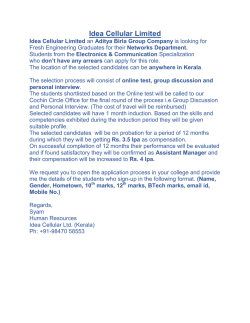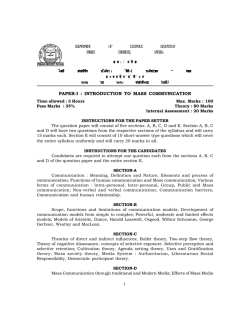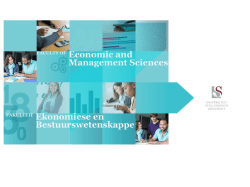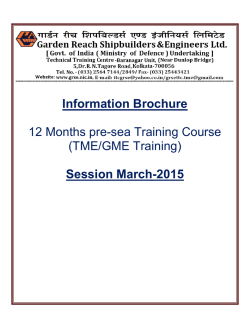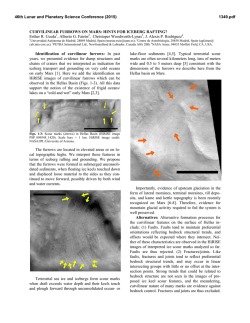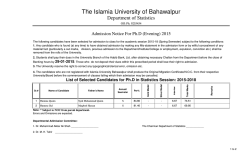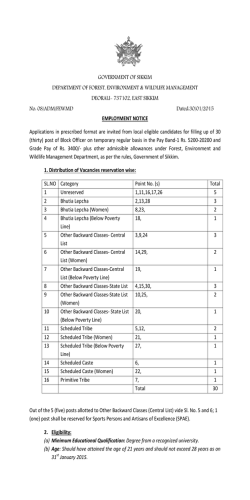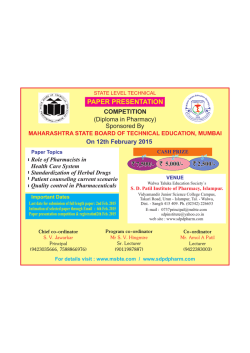
department of distance education punjabi university
DEPARTMENT OF DISTANCE EDUCATION
PUNJABI UNIVERSITY, PATIALA
SYLLABUS
B.COM PART-I (ANNUAL SYSTEM)
2014-2015 EXAMINATION
SCHEME OF STUDY
Maximum Marks
BC 101 Punjabi
100 Marks
BC 101-A w[Ybk frnkB
(Special Paper in lieu of Punjabi)
100 Marks
BC 102 English (Communication Skills)
50 Marks
BC 103 Business Mathematics & Statistics
100 Marks
BC 104 Financial Accounting
100 Marks
BC 105 Business Regulatory Framework
100 Marks
BC 106 Computer Applications in Business
100 Marks
BC 107 Business Economics
100 Marks
phH;hH 101 L gzikph (bk}wh)
e[Zb nze L 100
;wK L 3 xzN/
1H
2H
ftµ/ ftu'I gk; j'D bJh 35% nze
f;b/p; s/ gkm-g[;seK
u'Dt/_ gzikph fBpzX, (;zgkde vkH i'frzdo f;zx g[nko ns/ vkH gowihs f;zx f;ZX{), gzikph
:{Bhtof;Nh, gfNnkbk. (fszB b/y @wB dh w"i#, @Gkos ftu ebk#, @dk; wb{ek :{z
eo/I#, f;b/p; dk fjZ;k BjhI jB).
ejkDh ;zrqfj - @eEk ozr# (;zgkde tfonkw f;zx ;zX{ s/ vkH pbd/t f;zx uhwk)
(i)
g?ok-ouBk (tksktoDh w;b/ ns/ ;wkXkB (tksktoD Bkb ;zpzfXs b/y ;zrqfj) ;zgkH
vkH pbd/t f;zx uhwk, vkH vhHghH f;zx (b/y-1, 2, 3, 4)
(ii)
g?ok gVQ e/ gqFBK d/ T[Zso.
ftnkeoB
3H
(T)
(n)
ftnkeoB d/ p[fBnkdh sZs
gzikph X[Bh-ftT[Is L ;Po, ftnziB, T[ukoB nzr, T[ukoB ;EkB s/ T[ukoB
1
B.Com. Part-I
2
Syllabus
ftXhnK.
(J)
GkFk tzBrhnK L GkFk dk Ne;kbh o{g, GkFk ns/ T[g-GkFk dk nzso ns/ nzso;zpzX, gzikph T[gGkFktK s/ gSkD fuzBQ.
(;)
Fpd-pDso ns/ Fpd ouBk L gfoGkFk, w[Yb/ ;zebg.
(j)
Fpd-Fq/DhnK ns/ o{gKsoB.
eqwKe 1, 2 ns/ 3 d/ nkXko s/ S'N/ gqFB.
nze tzv ns/ g/go-;?No bJh jdkfJsK
1H
fe;/ fBpzX dk ;ko iK T[; dk ftµk t;s{ (d' ftu'I fJe)
15 nze
2H
fe;/ ejkDh dk ftFk t;s{$ebk$ejkDh b/ye pko/ ikDekoh s/ T[;dk :'rdkB (d' ftu'I
fJe)
15 nze
3H(i)
g?oQk-ouBk tksktoD ns/ tksktoD u/sBk Bkb ;zpzfXs fszB ftfFnK ftu'I fe;/ fJe T[s/
g?oQk fbyD bJh fejk ikt/.
(ii)
g?oQk d/ e/ T[; pko/ gzi gqFBK d/ T[Zso.
BzH 3 T[s/ fdZs/ ftnkeoB d/ nkXko T[Zs/ toDBkswe gqFB.
4H
5H(i)
(ii)
5O5=10 nze
20 nze
eqwKe L 1 ns/ 2 s/ doi gkm-g[;seK ftu'I gzi tkeK dh GkFk dk ftjkfoe ftnkeofBe
ftFb/FD. fJj gqFB Bzpo 4 ftu fBoXkfos ftnkeoBe tkb/ gZyK T[s/ jh nkXkfos
j'tr
/ k.
5x4=20 nze
eqwKe 1, 2 ns/ 3 d/ nkXko s/ 10 S'N/ gqFB g[ZS/ ikD.
10x2=20 nze
BC 101-A : w[Ybk frnkB
;wK L 3 xzN/
e[Zb nze L 100
nzdo{Bh w[bKeD L 20
pkjoh w[bKeD L 80
1H
r[ow[yh toBwkbk s/ b/yD-gqpzX
(T)
(n)
2H
r[ow[yh nZyo s/ gzikph X[BhnK dk gqpzX
(T)
;to s/ ftnziD L torheoB d/ f;XKs s/ T[ukoB.
(n)
;to ;{ue nZyoK s/ X[BhnK dh gSkD s/ tos'I.
(J)
(;)
3H
nZyo f;Zfynk L soshptko s/ G[bkt/I nZyo.
nZyo pDso L nZyo o{g s/ b/yD d/ fB:w.
ftnziD ;{ue nZyoK s/ X[BhnK dh gSkD s/ tos'I.
br wksok dh gSkD s/ tos'I.
(j)
brkyoK dh gSkD s/ tos'I.
fbgh d/ nZyoK dh tos'I d/ fB:w
B.Com. Part-I
4H
5H
(T)
(n)
g{o/ s/ nZX/ nZyoK dh gSkD s/ tos'I
;to ;{ue nZyoK dh gSkD s/ tos'I
(J)
(;)
;to tkjeK dh gSkD s/ tos'I
wksok s/ ;to tkjeK dh ;KMh tos'I
(n)
(J)
j\s/ d/ fdB
ozrK d/ BK
(;)
(j)
gF{ gzShnK d/ BK
gzikph foFsk-Bksk gqpzX dh Fpdktbh
(e)
xo/b{ t;sK dh Fpdktbh
Fpd gqpzX L Fpd i'VK dh tos'I
(T)
d' nZyoh FpdK d/ Fpd i'V
1H
ftnkeoBe torK dh gSkD s/ tos'I
(fbzr, tuB, g[oy, ekb nkfd)
Fpd pDsoK s/ ftnkeoBe fJekJhnK dk f;XKs, gSkD s/ tos'I
(T)
gzikph Fpd pDsoK dk f;XKs, gSkD s/ tos'I
(nr/so, fgS/so, ;wk;, d[jo[esh)
(n)
8H
fszB nZyoh FpdK d/ Fpd i'V
pj[ nZyoh FpdK d/ Fpd i'V
FpdK dhnK Fo/DhnK s/ ftnkeoBe torK dh gSkD
(T)
FpdK dhnK Fo/DhnK dk f;XKs, gSkD s/ tos'I
(BKt, gVBKt, ftF/FD, fefonk, fefonk ftF/FD nkfd)
(n)
7H
Syllabus
(j)
wksok dh ftnziD ;{ueK Bkb tos'I
gzikph Fpdktbh Bkb ikD gSkD
(T)
frDsh
(n)
(J)
6H
3
ftnkeoBe fJekJhnK dk f;XKs, gSkD s/ tos'I
(tkezF, T[g-tke s/ tke)
(J)
FpdK dk ftnkeoBe w/b f;XKs s/ ftjko
ftFokw fuzBQK dh gSkD s/ tos'I
;jkfJe g[;seK
;fsBkw f;zx ;zX{, nkT gzikph f;ZyhJ/, gpbhe/FB fpT{o', gzikph :{Bhtof;Nh, gfNnkbk,
2009, (fjzdh s'I gzikph f;ZyD bJh).
B.Com. Part-I
2H
3H
4H
Syllabus
4
;fsBkw f;zx ;zX{, r[ow[yh f;Zy', gpbhe/FB fpT{o', gzikph :{Bhtof;Nh, gfNnkbk, 2011
(nzro/}h s'I gzikph f;ZyD bJh).
;hsk okw pkjoh, gzikph f;ZyhJ/, gpbhe/FB fpT{o', gzikph :{Bhtof;Nh, gfNnkbk, 2002
(fjzdh)
okiftzdo f;zx, gzikph frnkB ;hHvhH (ezfgT{No n?gbhe/FB N{-boB n?Iv Nhu gzikph),
gpbhe/FB fpT{o', gzikph :{Bhtof;Nh, gfNnkbk, 2011
5.
Hardev Bahri, Teach Yourself Punjabi, Publication Bureau, Punjabi University,
Patiala, 2011.
6.
Henry A. Gleason and Harjeet Singh Gill, A Start in Punjabi, Publication
Bureau, Punjabi University, Patiala, 1997.
7.
Ujjal Singh Bahri and Paramjit Singh Walia, Introductory Punjabi, Publication
Bureau, Punjabi University, Patiala, 2003.
BC 102 : ENGLISH (COMMUNICATION SKILLS)
Time Allowed : 3 hours
Max. Marks : 50
Pass Marks : 35%
COURSE CONTENT AND TESTING
Text Prescribed (Literary) :
Contemporary English Prose (OUP) edited by K.P.K. Menon
The following stories/essays are not to be studied :
(i)
Uncle Podger Hangs a Picture
(ii)
Sweets
(iii)
Lectures
(iv)
The Position of Women in Ancient India
(v)
Self Portrait
TESTING :
Q. 1 (a)
One essay-type question with an internal alternative on summary,
theme, incident or character in about 250 words.
(b)
Five short answer questions to be attempted out of the given eight from
the prescribed text in about 30 words each.
(c)
Comprehension of a prose passage of about 150 words from the
prescribed text in the following way :
(i)
Three questions to test the comprehension of the passage.
B.Com. Part-I
(ii)
Q.2
Syllabus
5
Meanings of two words/phrases italicized in the passage and use thereof
in illustrative sentences.
5+5+5=15 Marks
Business Letters
The students may be asked to write a letter of the following types with an
internal alternative :
Q.3
Q.4
(a)
Placing an order
(b)
Cancelling an order
(c)
Complaints
(d)
Reply to complaints
(e)
Asking for quotations
(f)
Status enquiry letters
(g)
Favourable/unfavourable reply to status enquiry
(h)
Seeking dealership of a particular product etc.
10 Marks
Preparing Advertisement Copies of the following types :
(a)
Classified Advertisements
(b)
Display advertisement for your products and services. The students
should be asked to attempt one of the given two advertisements. 6 Marks
Resume Writing
The nature of the job should be specified so as to enable the students to prepare
their resume accordingly.
7 Marks
Q.5
Grammar and Vocabulary
(a)
Idioms and Phrases (Meaning and Usage)
(b)
Synonyms and Antonyms
(c)
Expanding abbreviations and acronyms pertaining to Commerce,
Business, Economics.
The students should be asked to attempt four of the given six from part (a) and
eight out of the given ten from part (b) and part (c) each.
4+4+4=12 Marks
BC 103 : BUSINESS MATHEMATICS & STATISTICS
Time Allowed : 3 Hours
Max. Marks : 100
Pass Marks : 35%
INSTRUCTIONS FOR THE PAPER-SETTER
The question paper will consist of five sections : A, B, C, D and E. Sections A, B, C
and D will have two questions from the respective sections of the syllabus and will
B.Com. Part-I
6
Syllabus
carry 15 marks each. Section E will have one question having 12 short answer type
questions (including at least four numerical type questions) of four marks each which
will cover the entire syllabus uniformly.
INSTRUCTIONS FOR THE CANDIDATES
Candidates are required to attempt one question each from sections A, B, C and
D of the question paper and 10 short answer type questions (answer to be around 50
words each) from section E.
SECTION - A
Matrices and Determinants : Definition of a matrix; Types of matrices; Algebra
of matrices; Properties of determinants; Calculation of values of determinants upto
third order; Adjoint of a matrix, elementary row or column operations; Finding inverse
of a matrix through adjoint and elementary row or column operations; Solution of a
system of linear equations having unique solution and involving not more than three
variables.
Compound Interest and Annuities : Certain different types of interest rates;
Concept of present value and amount of a sum; Types of annuities; Present value
and amount of an annuity, including the case continuous compounding; Valuation
of simple loans and debentures; Problems relating to sinking funds.
SECTION-B
Linear Programming—Formulation of LPP : Graphical method of solution;
Problems relating to two variables including the case of mixed constraints; Cases
having no solution; multiple solutions, unbounded solution and redundant
constraints.
Simplex Method—Solution of problems upto three variables, including cases
of mixed constraints; Duality; Transportation Problem and Assignment Problem.
SECTION-C
Introduction to Statistics-Definition, Importance and Limitations. Functions
and scope. Measures of Central Tendency : Mean, Median, Mode.
Analysis of Time Series : Causes of variations in time series multiplicative
models; Determination of trends, Moving averages method and method of least squares
(including linear, second degree, parabolic and exponential trends); Computation
of seasonal-indices by simple averages, ratio-trend, ratio-to-moving average and link
relative methods.
SECTION-D
Correlation : Meaning, types and measurement of correlation (Karl Pearson's
methods and Spearman's rank correlation). Regression; Meaning, Regression
B.Com. Part-I
Syllabus
7
Equation of X on Y and Y on X.
Forecasting Methods : Forecasting concept, types and importance; General
approach to forecasting; Methods of forecasting; Forecasting demand; Industry Vs.
Company sales forecasts; Factors affecting company sales.
RECOMMENDED BOOKS
1.
D.R. Sharma and Sham Lal :
Business Math & Statistics
2.
R.P. Hooda
:
Statis. for Business & Economics
3.
S.P. Gupta
:
Stat. Method
4.
S.C. Gupta & V.K. Kapoor
:
Fundamentals of Applied Management
BC 104 : FINANCIAL ACCOUNTING
Time Allowed : 3 Hours
Max. Marks : 100
Pass Marks : 35%
INSTRUCTIONS FOR THE PAPER-SETTER
The question paper will consist of five sections : A, B, C, D and E. Sections A, B, C
and D will have two questions from the respective sections of the syllabus and will
carry 15 marks each. Section E will have one question having 12 short answer type
questions (including at least four numerical type questions) of four marks each which
will cover the entire syllabus uniformly.
INSTRUCTIONS FOR THE CANDIDATES
Candidates are required to attempt one question each from sections A, B, C and
D of the question paper and 10 short answer type questions (answer to be around 50
words each) from section E.
SECTION-A
Accounting : Meaning Scope and Importance, Branches of Accounting,
Accounting Concepts and Conventions, Double Entry System, Preparation of Journal,
Subsidiary Books including Cash Book, Ledger, Trial Balance, Preparation of Final
Accounts of Sole Traders and Partnership Firms.
SECTION-B
Distinction between Capital and Revenue items, Errors and their Rectification;
Bank Reconciliation Statement, Depreciation Methods and Accounting including
AS-6, Accounts of non-trading concerns including Hospital and Educational
Institutions.
SECTION-C
Accounts relating to Partnership : Admission, Retirement and Death of a
Partner, Dissolution of Partnership including Garner Vs. Murray rule, Amalgamation
B.Com. Part-I
Syllabus
8
of Firms, Sale of firm to a Company and Conversion of a firm in a company, Gradual
Realisation of Assets and Piece Meal Distribution.
SECTION-D
Branch Accounts, Insurance Claims, Stock. Valuation and AS-2, Hire
Purchase and Instalment, E-Accounting : its meaning, features, limitations and
advantages.
BOOKS RECOMMENDED
1.
M.C. Shukla & T.S. Grewal
:
Advanced Accounts
2.
R.L. Gupta
:
Advanced Accounts
3.
S.N. Maheswari
:
Advanced Accounting
4.
V.P. Sharma & Others
:
Advanced Accouting
5.
A.K. Dhir
:
Advanced Accouting
BC 105 : BUSINESS REGULATORY FRAMEWORK
Time Allowed : 3 Hours
Max. Marks : 100
Pass Marks : 35%
INSTRUCTIONS FOR THE PAPER-SETTER
The question paper will consist of five sections : A, B, C, D and E. Sections A, B, C
and D will have two questions from the respective sections of the syllabus and will
carry 15 marks each. Section E will have one question having 12 short answer type
questions (answer to be around 50 words each) of four marks each which will cover
the entire syllabus uniformly.
INSTRUCTIONS FOR THE CANDIDATES
Candidates are required to attempt one question each from the sections A, B, C
and D of the question paper and 10 short answer type questions (answer to be around
50 words each) from section E.
SECTION-A
Law of Contract (1872) : Nature of contract, Classification; Offer and acceptance;
Capacity of parties to contract; Free consent; Consideration; Legality of object;
Agreements declared void; Performance of contract; Discharge of contract; Remedies
for breach of contract.
SECTION-B
Special Contracts : Indemnity; Guarantee; Bailment and Pledge; Agency.
Sales of Goods Act 1930 : Formation of Contracts of sale; Goods and their
classification, price; conditions and warranties; Transfer of property in goods;
B.Com. Part-I
Syllabus
9
Performance of the contract of sales; unpaid seller and his rights, sale by auction;
Hire purchase agreement.
SECTION-C
Negotiable Instrument Act 1881 : Definition of negotiable instruments,
Features; Promissory note; Bill of exchange and cheque; Holder and holder in the
due course; Crossing of a cheque, Types of Crossing; Negotiation; Dishonour and
discharge of negotiable instrument.
SECTION-D
The Consumer Protection Act 1986 : Salient features, Grievance redressal
machinery.
Environment Protection Act 1986, Introduction to RTI, IPR and Cyber Laws.
BOOKS RECOMMENDED
1.
Singh, Avtar
:
The Principles of Mercantile Law.
2.
Kuchhal M.C.
:
Business Law.
3.
Kapoor, N. D.
:
Business Laws.
4.
Chandra, P. R.
:
Business Law, Galgotia, New Delhi.
5.
Sharma, V. K.
:
Business Laws
BC 106 : COMPUTER APPLICATIONS IN BUSINESS
Time Allowed : 3 Hours
Max. Marks : 100
Theory : 70
Practical : 30
INSTRUCTIONS FOR THE PAPER-SETTER
The question paper will consist of five sections : A, B, C, D and E. Sections A, B, C
and D will have two questions from the respective sections of the syllabus and will
carry 10 marks each. Section E will have one question having 12 short answer type
questions (answer to be around 35 words each) of three marks each which will cover
the entire syllabus uniformly.
INSTRUCTIONS FOR THE CANDIDATES
Candidates are required to attempt one question each from sections A, B, C and
D of the question paper and 10 short answer type questions (answer to be around 35
words each) from section E.
INSTRUCTIONS FOR THE PRACTICAL EXAMINATIONS
The students would be required to solve any one problem out of two set by the
examiner based on the packages covered in the syllabus.
B.Com. Part-I
Syllabus
10
SECTION-A
Computer : Introduction, Functions and Classification of Computer, Overview
of Software and Hardware, Input and Output devices, Computer Memory : RAM, ROM,
Number System and its Inter Conversion. Introduction to Operating System, DOS
and WINDOWS, Working with files and folder, Understanding the control panel,
Opening and exiting Windows application, Copying and moving files and folders
using windows explorer.
SECTION-B
Introduction to MS Word : Basic Features, Starting and exiting word, Creating,
Editing and Saving a Word document, Inserting Pictures and Symbols, Working with
text, Creating a Table, Formatting Documents, Previewing and Printing Documents,
Introduction to MS Power Point : Power Point Basics, Creating and Saving,
Presentations, Inserting Pictures and Graphics, Inserting slides from other
Presentations, Slide Show View.
SECTION-C
Introduction to MS Excel : Creating spread sheets by entering text formulas
and numbers. Introduction to financial functions in Excel, Making Graphs in Excel,
Sorting data in Excel, Conditional calculation using IF, IF....AND if OR. Basic
introduction to Internet and its applications : Search Engines and e-mail.
SECTION-D
Computerized Accounting : Introduction and advantages, use of Accounting
Package; TALLY for Journalizing and posting business transactions; creating
vouchers, preparing Trial Balance and Final Accounts and Bank Reconciliation
Statement.
BOOKS RECOMMENDED
1.
Microsoft Office 2000 Complete, BPB Publications.
2.
Alexis Leon, Mathews Leon :
3.
Implementing Tally, BPB Publications.
4.
PC Complete, BPB Publications.
5.
Jana Calabria
:
Introduction to Computers with MS
Office 2000, Tata McGraw.
Windows 98—6 in 1, Prentice Hall.
BC 107 : BUSINESS ECONOMICS
Time Allowed : 3 Hours
Max. Marks : 100
Pass Marks : 35%
INSTRUCTIONS FOR THE PAPER-SETTER
The question paper will consist of five sections : A, B, C, D and E. Sections A, B, C
B.Com. Part-I
11
Syllabus
and D will have two questions from the respective sections of the syllabus and will
carry 15 marks each. Section E will have one question having 12 short answer type
questions (answer to be around 50 words each) of four marks each which will cover
the entire syllabus uniformly.
INSTRUCTIONS FOR THE CANDIDATES
Candidates are required to attempt one question each from sections A, B, C and
D of the question paper and 10 short answer type questions (answer to be around 50
words each) from section E.
SECTION-A
Consumer behaviour : Utility approach, A brief outline of law of diminishing
marginal utility and law of equi-marginal utility, Indifference curve approach :
Consumer equilibrium, income, price and substitution effects. Law of demand,
derivation of law of demand based on utility analysis and indifference curve analysis;
Elasticity of Demand Concept, Price elasticity of demand and its measurement.
SECTION-B
Concept of production function, Breakeven analysis, profit forecasting in short
run. Law of variable proportion, Returns to scale, Internal and external economies
and diseconomies. Concept of total, average and marginal revenue and elasticity of
demand. Isoquant technique and producer's equilibrium.
SECTION-C
Price determination under perfect competition, monopoly and monopolistic
competition and oligopoly : price policy; pricing in public sector enterprises.
SECTION-D
Introduction to Macro Economics and its importance, National Income :
Methods and problems of measurement particularly in underdeveloped countries.
Classical theory of Employment and Say's Law of Market, Keynesian Theory of Income,
Output and Employment.
BOOKS RECOMMENDED
1.
M. L. Seth
:
Principles of Economics
2.
Stonier and Hague
:
A Text Book of Economics
3.
K. K. Sharma and others
:
Business Economics
Laser Type-Setting By :
Computer Lab, Department of Distance Education, Punjabi University, Patiala
© Copyright 2025
